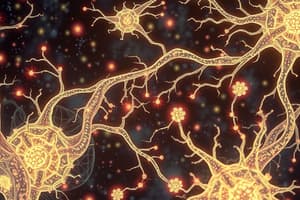Podcast
Questions and Answers
What is the typical value of the resting membrane potential in a neuron?
What is the typical value of the resting membrane potential in a neuron?
-70mV
True or False: During the resting state, the outside of the neuron's membrane is positively charged, and the inside is negatively charged.
True or False: During the resting state, the outside of the neuron's membrane is positively charged, and the inside is negatively charged.
True (A)
In the resting phase, which ion is more concentrated outside the neuron membrane compared to inside?
In the resting phase, which ion is more concentrated outside the neuron membrane compared to inside?
Sodium ions (Na+)
In the resting phase, which ion is more concentrated inside the neuron membrane compared to outside?
In the resting phase, which ion is more concentrated inside the neuron membrane compared to outside?
What is an action potential (AP)?
What is an action potential (AP)?
True or False: During an action potential, the inside of the neuron membrane becomes more negative.
True or False: During an action potential, the inside of the neuron membrane becomes more negative.
What happens to the neuron's membrane potential during the depolarizing phase of an action potential?
What happens to the neuron's membrane potential during the depolarizing phase of an action potential?
What occurs during the repolarizing phase of an action potential?
What occurs during the repolarizing phase of an action potential?
Describe the after-hyperpolarizing phase of an action potential.
Describe the after-hyperpolarizing phase of an action potential.
Flashcards
Resting Membrane Potential
Resting Membrane Potential
The charge difference across the plasma membrane of a neuron, typically around -70mV.
Charge of Membrane
Charge of Membrane
Extracellular positive charge and intracellular negative charge
Resting Phase Ions
Resting Phase Ions
Positively charged ions, including sodium and potassium, in the cytoplasm.
Action Potential (AP)
Action Potential (AP)
Signup and view all the flashcards
Ion Concentration
Ion Concentration
Signup and view all the flashcards
Membrane Polarity during AP
Membrane Polarity during AP
Signup and view all the flashcards
Depolarizing Phase
Depolarizing Phase
Signup and view all the flashcards
Repolarizing Phase
Repolarizing Phase
Signup and view all the flashcards
Hyperpolarizing Phase
Hyperpolarizing Phase
Signup and view all the flashcards
Study Notes
Generation of Action Potential
- There is normally a charge difference across the plasma membrane of a neuron.
- The value of resting membrane potential is -70mV.
- The outside of the membrane has a positive charge and inside has a negative charge.
- Resting phase involves sodium and potassium positively charged ions and negatively charged ions in the cytoplasm.
- Sodium ions are more concentrated outside the membrane, while potassium ions are more concentrated inside the membrane.
Action Potential (AP)
- It is a momentary change in the membrane potential.
- Caused by a transient change in the membrane's permeability to sodium and potassium ions.
- The inside of the membrane becomes more positive.
- As a result of ion flow through these channels, the inside of a neuron briefly becomes more positive than outside.
- AP has three main phases.
Depolarizing phase
- The negative membrane potential becomes less negative, reaches zero, and then becomes positive.
Repolarizing phase
- The membrane potential is restored to the resting state of -70mV.
After hyperpolarizing phase
- The membrane potential temporarily becomes more negative than the resting level.
Studying That Suits You
Use AI to generate personalized quizzes and flashcards to suit your learning preferences.



